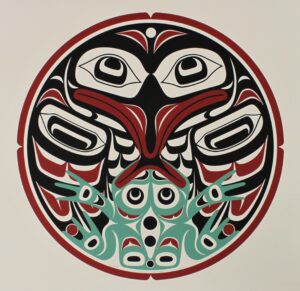The frog holds great significance in Northwest Coast Native art and culture, frequently appearing on totem poles, house posts, and various household items.
In nature, frogs seamlessly transition between water and land, symbolizing renewal, transformation, and the changing seasons. Their loud croaking in the spring signals the end of winter ceremonies for Northwest Coast tribes, marking the time to prepare for the upcoming hunting and fishing season.
Across many Indigenous cultures in North and South America, frogs are seen as healers. Some ancient European traditions also recognize their healing abilities, believing their songs possess magical and divine power. Shamans consider frogs to be powerful spirit helpers, capable of cleansing bad spirits.
As a supernatural being, the frog exists in both the human and spirit worlds, serving as a bridge between the two realms. Its adaptability allows it to communicate between these worlds with ease.
In Northwest Coast art, frogs are often depicted with wide mouths and protruding tongues, as seen in Wak’es, Tree Frog. When a frog’s tongue touches another creature, it represents the sharing of knowledge and power, as illustrated in Sharing Knowledge.
On totem poles, frogs are typically placed at the base with their legs stretched out, symbolizing stability. Among the Haida, they are also carved into house posts to provide structural support.
Beyond their spiritual significance, frogs represent wealth, abundance, ancient wisdom, rebirth, and good fortune.

by Alvin Child